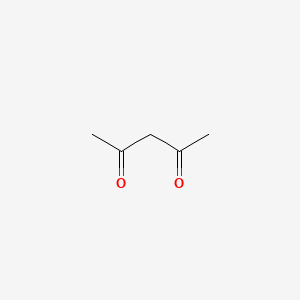| MeSH term | MeSH ID | Detail |
|---|---|---|
| Adenocarcinoma | D000230 | 166 associated lipids |
| Dermatitis, Contact | D003877 | 59 associated lipids |
| Body Weight | D001835 | 333 associated lipids |
| Edema | D004487 | 152 associated lipids |
| Purpura, Thrombocytopenic | D011696 | 2 associated lipids |
| Glioma | D005910 | 112 associated lipids |
| Nervous System Diseases | D009422 | 37 associated lipids |
| Seizures | D012640 | 87 associated lipids |
| Fetal Resorption | D005327 | 15 associated lipids |
| Carcinoma, Lewis Lung | D018827 | 22 associated lipids |
2,4-pentanedione
2,4-pentanedione is a lipid of Fatty Acyls (FA) class. The related lipids are Butyrates.
Cross Reference
Introduction
To understand associated biological information of 2,4-pentanedione, we collected biological information of abnormalities, associated pathways, cellular/molecular locations, biological functions, related genes/proteins, lipids and common seen animal/experimental models with organized paragraphs from literatures.
What diseases are associated with 2,4-pentanedione?
There are no associated biomedical information in the current reference collection.
Possible diseases from mapped MeSH terms on references
We collected disease MeSH terms mapped to the references associated with 2,4-pentanedione
PubChem Associated disorders and diseases
What pathways are associated with 2,4-pentanedione
There are no associated biomedical information in the current reference collection.
PubChem Biomolecular Interactions and Pathways
Link to PubChem Biomolecular Interactions and PathwaysWhat cellular locations are associated with 2,4-pentanedione?
There are no associated biomedical information in the current reference collection.
What functions are associated with 2,4-pentanedione?
There are no associated biomedical information in the current reference collection.
What lipids are associated with 2,4-pentanedione?
Related references are published most in these journals:
| Lipid concept | Cross reference | Weighted score | Related literatures |
|---|
What genes are associated with 2,4-pentanedione?
There are no associated biomedical information in the current reference collection.
What common seen animal models are associated with 2,4-pentanedione?
There are no associated biomedical information in the current reference collection.
NCBI Entrez Crosslinks
All references with 2,4-pentanedione
Download all related citations| Authors | Title | Published | Journal | PubMed Link |
|---|---|---|---|---|
| pmid:15448970 | ||||
| pmid:15446866 | ||||
| pmid:15387583 | ||||
| pmid:15387573 | ||||
| pmid:15372674 | ||||
| pmid:15360263 | ||||
| Brombacher H and Vahrenkamp H | Pyrazolylborate-zinc alkoxide complexes. 3. Acid-base reactions. | 2004 | Inorg Chem | pmid:15360256 |
| pmid:15349164 | ||||
| Kandasamy K et al. | Synthesis, structure, and catalytic properties of V(IV), Mn(III), Mo(VI), and U(VI) complexes containing bidentate (N, O) oxazine and oxazoline ligands. | 2004 | Inorg Chem | pmid:15332823 |
| pmid:15332816 | ||||
| pmid:15332617 | ||||
| pmid:15313157 | ||||
| pmid:15307777 | ||||
| pmid:15306927 | ||||
| pmid:15285668 | ||||
| pmid:15285667 | ||||
| Osinsky S et al. | Selectivity of effects of redox-active cobalt(III) complexes on tumor tissue. | 2004 | Exp. Oncol. | pmid:15273664 |
| pmid:15252496 | ||||
| pmid:15252485 | ||||
| Yang XG et al. | The permeability and cytotoxicity of insulin-mimetic vanadium compounds. | 2004 | Pharm. Res. | pmid:15212169 |
| McCloud LL et al. | beta-hydroxybutyrate induces acute pulmonary endothelial dysfunction in rabbits. | 2004 Apr-May | Exp. Lung Res. | pmid:15195553 |
| Anthon GE and Barrett DM | Comparison of three colorimetric reagents in the determination of methanol with alcohol oxidase. Application to the assay of pectin methylesterase. | 2004 | J. Agric. Food Chem. | pmid:15186092 |
| pmid:15180409 | ||||
| pmid:15174875 | ||||
| pmid:15147701 | ||||
| pmid:15134921 | ||||
| pmid:15132640 | ||||
| Kameta N et al. | Co-extraction of lanthanoid(III) with various metal ions in the chelate extraction system with acetylacetone. | 2004 | Anal Sci | pmid:15116978 |
| pmid:15113196 | ||||
| Yoo H et al. | Quantifying carbon sources for de novo lipogenesis in wild-type and IRS-1 knockout brown adipocytes. | 2004 | J. Lipid Res. | pmid:15102881 |
| pmid:15084328 | ||||
| Perotti C et al. | Porphyrin synthesis from ALA derivatives for photodynamic therapy. In vitro and in vivo studies. | 2004 | Br. J. Cancer | pmid:15083200 |
| Gryllaki-Berger M et al. | A comparative study of formaldehyde detection using chromotropic acid, acetylacetone and HPLC in cosmetics and household cleaning products. | 1992 | Contact Derm. | pmid:1505179 |
| pmid:14989651 | ||||
| pmid:14982405 | ||||
| pmid:14966958 | ||||
| pmid:14966876 | ||||
| DWYER FP and GYARFAS EC | Preparation of the optical forms of tris-acetylacetone cobalt III. | 1951 | Nature | pmid:14852937 |
| Pechmann T et al. | A new family of dinuclear rhodium complexes containing tertiary phosphanes in a semibridging or doubly bridging bonding mode. | 2004 | Chemistry | pmid:14767938 |
| Ikarashi Y et al. | [Examination related to revised test method for determination of formaldehyde, regulated by the law for the control of household products containing harmful substances]. | 2003 | Kokuritsu Iyakuhin Shokuhin Eisei Kenkyusho Hokoku | pmid:14740400 |
| pmid:14709102 | ||||
| Tanaka F et al. | Evolution of aldolase antibodies in vitro: correlation of catalytic activity and reaction-based selection. | 2004 | J. Mol. Biol. | pmid:14698295 |
| Hofer H et al. | Diketone cleaving enzyme Dke1 production by Acinetobacter johnsonii--optimization of fermentation conditions. | 2004 | J. Biotechnol. | pmid:14687973 |
| pmid:14685339 | ||||
| Hu M et al. | [Assessing the content of formaldehyde in vermicelli in Changsha market]. | 2003 | Wei Sheng Yan Jiu | pmid:14650195 |
| pmid:14648903 | ||||
| pmid:14632533 | ||||
| pmid:14611776 | ||||
| pmid:14606824 | ||||
| Nakano H and McCormick DB | Modification of arginyl and lysyl residues of flavokinase from rat small intestine. | 1992 | Biochem. Int. | pmid:1336380 |
